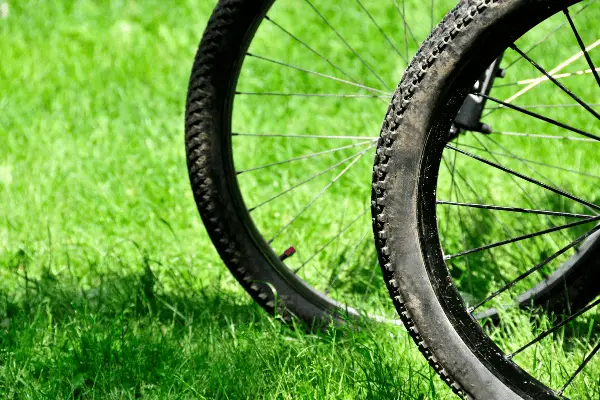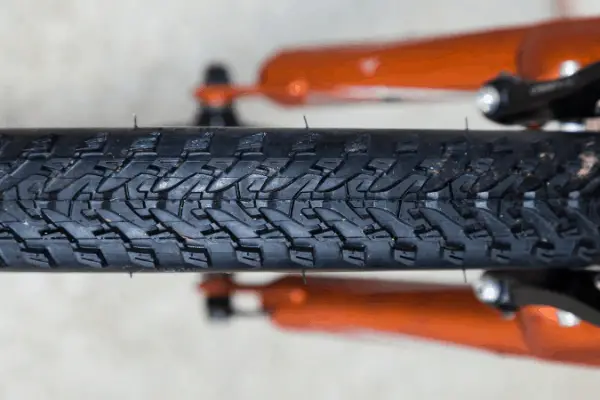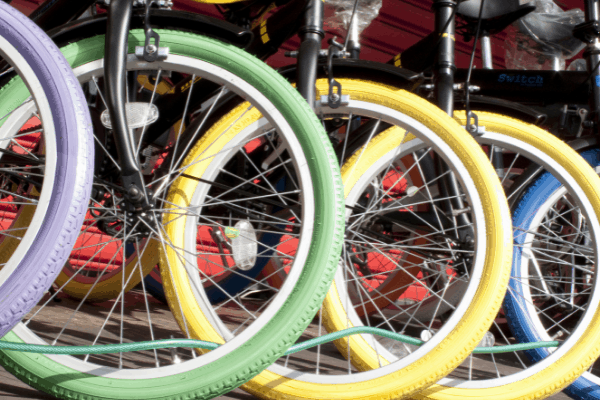Whether it’s for your car or your BMX bike, you can’t go where you need to go if you have no tires. Tires are the most important aspect of any mode of transportation and should constantly be checked and monitored to ensure that they’re perfect. That being said, flat tires are also one of the most common problems that you can encounter. Especially if you have a bike and you’re using it for rougher terrain.
If you find yourself spending more time taking care of flat tires than you do riding your bike, you might want to consider shifting to tubeless tires.
Tubeless tires are the newest technology, and though a bit more expensive, they may be exactly what you need to fulfill your biking needs.
Tubeless tires are most often used for mid to high-end bikes and often used for mountain bikes but are slowly being used in road bikes.
It may seem scary to think about shifting to tubeless tires when you’re not even aware of what they are.
But believe us, it’s a significant change and is bound to make you feel less anxious taking your bike out the next time around. Read on as we tell you more about tubeless tires and how they work.
What is a tubeless bike tire?
A tubeless bike tire is exactly what you think it is. It is a tire without any inner tubes. It looks like a normal tire, but it uses sealant, and once it is placed, it forms an airtight seal with the rim.
For this tech to work, no air must leave the tire or the sealant. These are pneumatic tires that don’t need a separate tube, but their required mechanism needs to be perfect. For tubeless tires, the following components are required:
- A compatible tire
- An airtight rim
- Spoke holes
- A tire bead seat
Read: All You Need to Know About Electric Bike Tires
How do tubeless bike tires work?
Tubeless tires work better than other options as they don’t require any extra tubes that can burst. It works by using the rubber itself to trap the air within the tire.
To put it more aptly, the tubeless bike tires work by preparing a seal between the bike tires and the rims, which means that you no longer require tubes in your tires.
You place the bead of the tires into the rim, and then this is kept in place using a sticky sealant that air seals the entire system stopping any air from escaping.
There are many benefits to these systems as opposed to conventional tires and tube tires. These are also lighter and more durable if your or the bike mechanic install them properly.
Conventional tires vs. Tubeless tires
There are three main types of bike tires:
- Clincher
- Tubular
- Tubeless
Clincher
These are the most common types of tires. The inner tube is inflated, which pushes the rims and the tire beads together. This system holds the tire together.
| Pros | Cons |
|---|---|
| Very common | Get punctured easily |
| Easy to install | Slightly heavy |
| Easy to maintain |
Tubular
Tubular tires also have an inner tube, much as the name suggests; however, different from clinchers, tubular have the tubes sealed into the rim, leaving no space in between.
| Pros | Cons |
|---|---|
| Highly refined ride quality | Flats |
| Least weight | Difficult to install |
| Rolling resistance |
Tubeless
Tubeless tires, as explained before, don’t have tubes and use a different mechanism compared to the other two categories. Here a sealant is used to make the tire impenetrable.
| Pros | Cons |
|---|---|
| It can be run at low pressures without many flats | More expensive |
| Fewer flats overall | Tricky installation |
| Great comfort | Sealant is messy and usually needs replacing |
| Better speed and grip | Need to be pumped more often than tubular tires |
| Lower rolling resistance |
Read: How to Change the Tire on an Electric Bike
Tubeless Ready vs. Tubeless Compatible
Tubeless tires are very common now, and they’re also often the most used for people who bike on the regular. They’re preferred for professional bikers or have to deal with more uneven terrain or excessive gravel.
When it comes to you as a casual buyer, you’ll need to assimilate to the terms Tubeless Ready, Tubeless compatible, and UST.
| Tubeless Ready | Tubeless Compatible |
| Dominant | Rim has a bead lock |
| They have tubeless-ready rims | Rim isn’t sealed itself |
| Tires have bead locks | Has the same setup as tubeless ready |
| Rims must have spoke beds sealed with tape | |
| Don’t have sealed casing | |
| Lighter | |
| Require sealant to hold air |
Tubeless-ready and tubeless-compatible are often used as synonyms. However, some mechanics prefer the distinction that the two present. Both of these specifications follow the UST.
The UST is an acronym that stands for universal system tubeless. It is a patented standard created in 1999. It is an engineering standard that many companies follow to make tires; however, only UST makes the rims and wheels.
So if a company or brand mentions the use or presence of UST rims and tires, you’re most likely to land yourself in a scam. Be careful to know fully about these specifications before investing in tubeless tires.
Read How to Remove Rust from Bikes
Should I switch to tubeless bike tires?
We have provided a comprehensive list of pros and cons earlier to make your choice easier. However, if we were to recommend it, we’d probably go tubeless because it lasts longer and is more durable and reliable.
The price of the shift might deter you; however, if you think it through, you spend more money on fixing punctures on your tubular tires, and the tubeless tires can make then make up the difference. The choice, however, might differ due to your priorities and the use of your bike.
Read: How Long Do Bike Tires Last
Should I try installing tubeless bike tires myself?
There’s no easy way to say this. Doing this by yourself is not easy and very often will make you feel frustrated and annoyed. But like anything, once it’s done, you’ll undoubtedly feel accomplished.
Many videos are detailing how you can install the tubeless tires yourself; however, we’re stating a few tips some of you first-timers out there will find helpful in the installation process.
One of the first things you need to know is that not all tires are compatible with the rims. It would be best if you had the materials sorted before you venture into the installation.
Make sure you have compatible tires and rim and ensure you have enough sealant before you proceed. Here’s a list of all the supplies you will need before you begin:
- Tire Sealant
- Tubeless valve stem
- Syringe
- Tire lever or two
- Rim tape in the correct width
- Valve core remover
- Needle nose pliers
- Air compressor or sturdy floor pump
- Paper towels or rugs
- Hairdryer (optional for sealing rim tape)
Once you’ve got all this material ready and in front of you, you can move towards thinking about installation. Installation is not an easy process by far, but it is manageable, and we’re here to give you some important tips:
- Like we said before, ensure that the tires and rims are tubeless compatible, so they sit right against each other.
- Tape the rim correctly with tubeless compatible (airtight) rim tape to ensure that the air doesn’t accidentally leak out. Tip: While doing this, make sure that the tape is taught, and then use a blow dryer to seal the tape in.
- Fit the valve stem into the rim. Tip: Before attempting this act, coat the base in sealant to prevent leaks.
- Now, move towards installing the tire onto the rim
- Helpful tips: You need to pre-seat the bead; a tire lever will be helpful with this.
- Remove the core of the valve stem and use a syringe to apply a sealant to the tire through the valve stem.
- You can now inflate the tires and move the sealant around to plug leaks. Continue to inflate the tire until the bead bulges out completely against the rim.
Apart from these methods, here are a couple of more helpful tips that will lead to a smoother installation:
- Suppose the tire doesn’t inflate fast enough to seat the bead; it might be helpful to remove the valve core to let the tire inflate quicker.
- Don’t be hasty and continue to inflate the tire while simultaneously moving sealant around. This act will cause prevent leaks and ensure a more successful installation.
- You can also run some soapy water on the tire or rim bead seat with a clean rag to ensure that the tire bead slips more efficiently.
Read What Is Faster a Bike or a Skateboard
Tubeless bike tires: Repair and Maintenance tips
The whole glamour around tubeless tires is that they’re less likely to puncture and thus easier to maintain.
That being said, tubeless bike tires aren’t completely impenetrable and, like any utility, require the proper repair and maintenance when something goes bust.
The repair and maintenance steps for tubeless tires are slightly different from tubular tires and require special supplies. Some of the repair supplies are listed below:
- Tire repair plugs of various sizes
- A curved needle and heavy-duty thread for large holes
- Extra sealant
- Spare tube, in case the seal is broken. A portable pump typically isn’t high-volume enough to re-seat a bead.
- Patch kit for that backup tube.
- Superglue
Now that you know what materials you might need, let’s look at some maintenance repair tips that will help you while biking with your tubeless tires.
Firstly, carry sealant around with you at all times. It’s a quick repair for most of the small punctures that may occur in your tires. If there’s a big gash, you can use any of the three: plugs, a patch, or a tube.
Choosing one of these three comes down to how new your sealant is. If it is relatively new, you’ll be okay with a couple of plugs. If not, it would be a better option to opt for a patch or replacing the entire tube.
This replacement is an arduous task so make sure you’re aware of the dates you’re renewing the sealant in your tubeless bike tires.
Furthermore, for large cuts, you can use several patch materials to continue using your bike. Bike mechanics and enthusiasts often recommend duct tape as it is enough to seal the cut close.
Other materials can also be used, such as pieces of leather or neoprene from old gloves. These materials need to be stitched in, though, where the curved needle and heavy-duty thread come in.
Having these handy will be a blessing; however, some resin-based glues may do the job. The problem with patches is that they’re often deemed a temporary fix. However, if situated properly, they can last quite a long while.
If the gash is too big for even a patch, it’s best to install a tube. However, before embarking on such an endeavor, you need to ensure that no thorns or other pieces of debris are stuck in the tire. If you even miss out on one thing, you’ll have wasted your time, your effort, and a tube.
Additionally, also ensure that you have latex gloves because they’ll protect you against a sealant.
Several people invest in tubeless bike tires because they are less of a hassle and lead to fewer flats. If you want to cut down the percentage of flats, even more, check your sealant regularly.
Ensure that you check it at least once every few months, pop the bead, and ensure that the sealant is still runny.
One way of making sure the sealant is still liquid is by shaking the tire and hearing for a sloshing sound. If one is heard, you’re good. If not, you need to remove the tire, clean it, remove any form of debris, and then apply a fresh sealant layer.
Tubeless tires are often hailed as fantastic with practically zero problems. The setup might be difficult and different, but the benefits are so many that most bike riders swear by them. If you can afford to buy and maintain them, then they seem like the superior choice.
However, if you don’t use your bike as often as you’d want to, then it’s better to stick to the tires you already have because the sealant in tubeless tires goes dry if not used often, and then it’s just not worth your while.
Read How much air pressure in bike tires
Terms to know as you make your switch to tubeless bike tires
Bead: It is the outer edge of a tire that sits against the rim. Most tubeless beads are designed using sturdy and strong material like Kevlar, so it doesn’t stretch out.
Bead hook: It is a lip that juts out on the upper inside of the rim walls and helps hold the tire bead in place. There are two in each tire.
The clincher: It is the most basic type of bike tire and has a horseshoe cross-section and beads that push into the rim under pressure. Tube-type and tubeless tires are both types of clinchers.
Hookless rim (or Tubeless Straight Side): It is a rim design that disallows the need for bead hooks
Sealant: It is a liquid that keeps the system from leaking air and helps in sealing punctures. There are various types of sealant, but it is mostly made up of tiny, solid particles of fiber or rubber suspended in some liquid matrix (like latex). The sealant sloshes around the tire when the bike is ridden, coats it to prevent general air loss, and seals smaller punctures.
Tubeless inflator: It’s a device to aid the seating of tubeless tires. It can also be incorporated into a pump.
Tubeless-ready: The term implies that the item is compatible with tubeless tires but can vary from brand to brand and so is not a universal standard.
Tubeless tape/rim tape: The tape you apply the inside of the rim to seal spoke holes and rim joins
Tubeless valve: It is a valve that fits through the valve hole in the rim and is secured with a nut to form a seal.
Tube-type: It means that the tire will require a tube as opposed to being tubeless
Tubular: A conventional design allows the tube to be fixed or inflated to stick to the rim.
UST: Mavic’s Universal System Tubeless standard. Several tire makers produce UST tires, but only Mavic and Mavic’s licensees produce UST rims.
You may like the following bike articles:
- Can You Pedal an Electric Bike With a Dead Battery?
- How to Determine E-Bike Battery Amp Hours
- When to Charge an Electric Bike: An Easy Guide for Beginners
- How Long Does a Battery Last on an Electric Bike?
- Can Mountain Bikes Get Wet?
- Best bike tire pumps
Final thoughts
Whether you go tubeless or decide to remain tubular, it is important to know the difference between the two before choosing. Answering the question, ‘how do tubeless bike tires work?‘ is likely to demystify its concepts and thus give you a better chance at making a better choice for yourself.

I am Michael, an avid rider and bike expert. I am here to provide, biking tips and expert advice on in-depth bike reviews covering features, capabilities, price range, and much more. Specially on electric bikes, mountain bikes, road bikes, etc. I will provide honest product reviews, along with expert advice on purchasing, training, and maintenance. Check out my complete profile.






